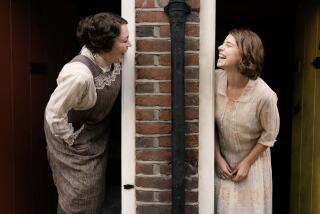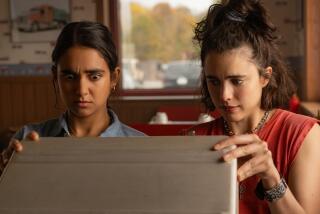The Envelope: For Gillian Flynn, ‘Gone Girl’ script began with wrestling a ‘monster’
My adaptation of “Gone Girl” began with a filthy, nasty amount of cursing. I really outdid myself. The [expletive] book was so [expletive] long and so [expletive] internal and so [expletive] unchronological … and what kind of [expletive] monster would write such a thing anyway? The answer to that last question was: me. I’d been cocksure certain I was the only person who should attempt to adapt my novel — it’s me, it has got to be me! Then, when my bluff was called and it actually came time to write the script, I realized, to my horror, I might actually have to write the script.
I had a number of abandoned screenplays on my laptop (plied with enough booze, I may tell you someday about my romantic comedy involving animatronic pigs), so I understood the form. But “understanding the form” only takes you so far.
“Gone Girl” is a story about a golden couple, Nick and Amy Dunne. Amy goes missing on their five-year anniversary, Nick becomes a suspect — then stuff really starts to happen. “Gone Girl” is as much about self-mythology and sexual gamesmanship as it is about a missing person, but the story has such an elaborate, Rube Goldbergian plot that my overriding fear was the script could become pure engine, a marriage plot with too much of the latter and not enough of the former.
So I listened to the audiobook and wrote down only the storylines that were absolutely necessary (or so I thought: Even some of these would go). I then put the plot points on notecards and taped them to my office wall because I’d read somewhere that’s what screenwriters did. I never looked at them again. I just left them there, to become a disturbing bit of wallpaper for anyone staying in the nearby guest room — my serial-killer scrawl with words like “DIES DIES DIES” or “THEY PLAY GOLF.”
What I did have at this point was a hazy outline of what the film might look like. Then I took a hot-pink stickie note and slapped it over my laptop. The note read: “IT IS A MOVIE.” It was a reminder not to be slavishly faithful to the novel. This had to become a film, not a series of scenes from the book. I wrote that first draft in the autumn of 2012 while I was still on book tour for “Gone Girl.” I wrote the final scene on a train from Chicago to Kalamazoo; on the ride home I decided to celebrate with a plastic glass of warm white wine. I sipped and read the scene. And thought: Not quite. I deleted it and started over.
I turned in the first draft to Fox on Dec. 14, 2012. By January, I was in Los Angeles meeting with David Fincher, thinking to myself: Do not gush like a tween and do not use the phrase “Fincheresque.” I was such a fangirl of his that I’d written certain scenes in the book — like the search in the abandoned mall — through his lens. (At one point, as we were trying to streamline the script, I suggested half-heartedly that we might, maybe be able to get rid of the mall scene, and his response, thank God, was an unequivocal no.)
Fincher and I had a lot of talks: about the nature of identity, of relationships, of gender. About “Lolita” and “Clockwork Orange” and the dark bursts of humor in those films. We fattened the script up and then winnowed it down. It got sharper, darker, sexier, funnier and more dangerous because of his thorough, incisive notes. He forced me to articulate and explain scenes. There’s nothing better for a writer than being called on her own writerly [nonsense]: You stumble partway through a justification of mediocrity and then just stop talking and go back to work.
I sat in on weeks of rehearsals with the cast, which helped me tailor the script to fit the actors. As the troubled Dunnes, Ben Affleck and Rosamund Pike enlivened and illuminated their scenes — both Amy and Nick’s first meeting and final tête-à-tête are deeply indebted to them and Fincher. By September 2013 —less than a year after I began writing the script — I was visiting the set in Missouri, wandering through a 3-D version of a story that had been in my brain for three years. I thought of that stickie note that had flapped over my laptop for months, like a bright pink fortune cookie: “IT IS A MOVIE.” No expletive required.
More to Read
From the Oscars to the Emmys.
Get the Envelope newsletter for exclusive awards season coverage, behind-the-scenes stories from the Envelope podcast and columnist Glenn Whipp’s must-read analysis.
You may occasionally receive promotional content from the Los Angeles Times.






